There are numerous patterns out there for establishing a watch schedule for ships at sea, with names like “The Swedish System” and the “Five and Dime”, all of which are trying to solve the problem of allocating shifts of people in continuous 24-hour operation. These systems are informed by the tasks required by time of day and what little we understand about sleep and the human psyche. This is a question that you will have to confront if you go out on a boat to sea, and what you find may not be what you expect.
As with most topics in the year leading up to our departure, in developing our own watch schedule I started with the collected wisdom of the Internet. Specifically, I scoured the Sailnet and cruiser forums for up-to-date practical experience. On rainy days I’d pull down one of the sailing books we’d collected since buying the boat and look back at what the age before had done, and what they knew of what came before them. From these I learned the familiar cadence of hours: 3, 4, 6, and 8, in all variations that added up to 24 and beyond, but there was no consistent answer. What did any of us know?


Supplement this with equations of belief about the natural rhythm of our brains. There are numerous myths to inform and in some cases confuse our beliefs. For instance did you know that Frank Sinatra only slept four hours a night and took 20-minute cat naps throughout the day, or that humans may be optimally adapted to 28-hour days, or how sleep debt is never actually repaid?
I believe our sleep comes in threes. I believe this because I read somewhere once (don’t ask me where) that the REM (rapid eye movement) sleep cycle occurs in three-hour sine waves, and I recall from watching Star Trek: The Next Generation that uninterrupted REM sleep is necessary to prevent distractedness, forgetfulness, irrationality, and in extreme cases insanity, violence, and telepathic dream states. This would be the cornerstone of Harmony’s and my watch schedule sleep construction.
The first experiment was straightforward: three hours on, three hours off. One waking cycle and one sleeping cycle, constant through the day and night. It didn’t take long for the cracks to appear. When will we don our many layers and shake off our grogginess? When will we eat and when are we supposed to feel tired vs. not? When can we (pardon the indelicateness) crap without it robbing us of vital sleep? Harmony proposed a slight modification: three hours on, three hours *and fifteen minutes* off.
Surprisingly, the effect was immediate and positive, if still not necessarily sustainable. The extra time to finish our three hour segment and take our time waking up seemed to reduce the low-grade shock that our bodies operated in spite of. After a while Harmony swore that we had actually agreed to three *and a half* hours off, and that I was inventing the memory of the 3:15 variant. I think she just stretched it when I wasn’t paying attention.
After that we added another variant to follow 2.5 hour shifts during the day and 3.5 during the night. Your guess is as good as mine as to what we were doing there.
Despite the deliberateness of our plan, we ended up swapping shifts as gifts or requests to self-medicate our down time and find our natural balance. Very few of our passages at this point had exceeded two nights, so there was little time to reach an equilibrium, but it was clear to us that something about our design wasn’t working. We both felt rushed, drained, and desperate for a good night’s sleep.
You see there was a complication in our math and our amateur bioscience, one that is more acutely prevalent to the small boat sailor than the Navy ships and freighters that employ their precise watch schedules. That complication is the wide uncertain sea. It disrupts our plans and schedules like a goblin under the hull, determined to keep you awake. When the weather is high for travel and you need your rest the most, it throws you from side to side and beats angrily on the walls. On a lake of glass it will roll you in its fingers just enough to send the boat’s most humble untethered pieces swinging and tapping and flopping and smacking enough to drive you barking mad. Something had to change, but we didn’t know how.
The key was 9:30pm. We were ten or twenty miles off the coast of some place or another, on our way to who knows where else. It was a warm night, calm with a sailing breeze, and we had just finished our customary dinner theater hour. This night’s fare was Breakfast for Dinner and Ru Paul’s Drag Race. Both cannot be recommended highly enough. It was the time of night when our normal life would start to wind down, and that time together was a window that we worked and suffered to preserve.
Harmony was scheduled to take over until 1:00am, then I’d be on until 4:30 and she’d pick up the sunrise shift. I know that she looks forward to watching the day start, but she looked ready for bed and it was clear she wasn’t looking forward to this. When I assessed myself I found something that had for years been sliding into dormancy as my life schedule syncopated with ‘business hours’ and ‘quality time’. I had sacrificed it on the altar of adulthood and good relationship practices, yet here it was: the steady buzz of a night owl. This was it, the crack in our universes. The difference that might make all the difference.
We decided to try a 6-6-3-3-3-3 combination, starting right then. I took Harmony’s shift and my own, and when she came on at 4:30, I crashed until 11. The night was brilliant, even moreso when seen through a wider scope with sleep not on your mind. Harmony woke up refreshed and ready to greet the sun of the new day. I woke up ready for lunch, coffee, and conversation (and captaining, of course).
Once we found this moment, the rest of the hours simply fell into place. We kept the three-hour shifts during the main part of the day, and toward evening we each catnapped and played and did galley work as our shared rhythms dictated. Sleep became a dance between us. Time finally became slow.
Since we found our signature watch schedule, we have also come to appreciate the passages longer than 3 days, because we found that by the third day we were fully acclimated to our shipboard metamorphosis and life felt completely normal.
It no doubt helped that The Doctor has done almost all the steering. Fortunately, the times we have to take over for him are infrequent or this would all go out the window and we’d have to start over.
The act of building a mutual sleep schedule is among the most intimate things that people do every day, yet it seems to be one of the most critical tasks to maintaining a healthy couple, crew, or species. This is another instance where our time on the sea has stripped us to our essential selves and helped us explore the finer points of our bond.
This will all change again when kids get thrown in the picture, I have no doubt. I foresee us on 1 1/2 hour cycles, Lord help us.
This was beautiful, Jeff! Loved this part: "When I assessed myself I found something that had for years been sliding into dormancy as my life schedule syncopated with ‘business hours’ and ‘quality time’. I had sacrificed it on the altar of adulthood and good relationship practices, yet here it was: the steady buzz of a night owl." It’s important to always assess ourselves! 🙂
Six and six during the night is exactly what we do! During the day we both just keep a lookout and naps in between. Nice post!
Verena
pacificsailors.com